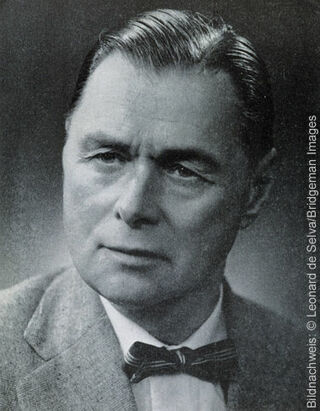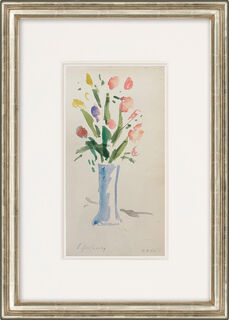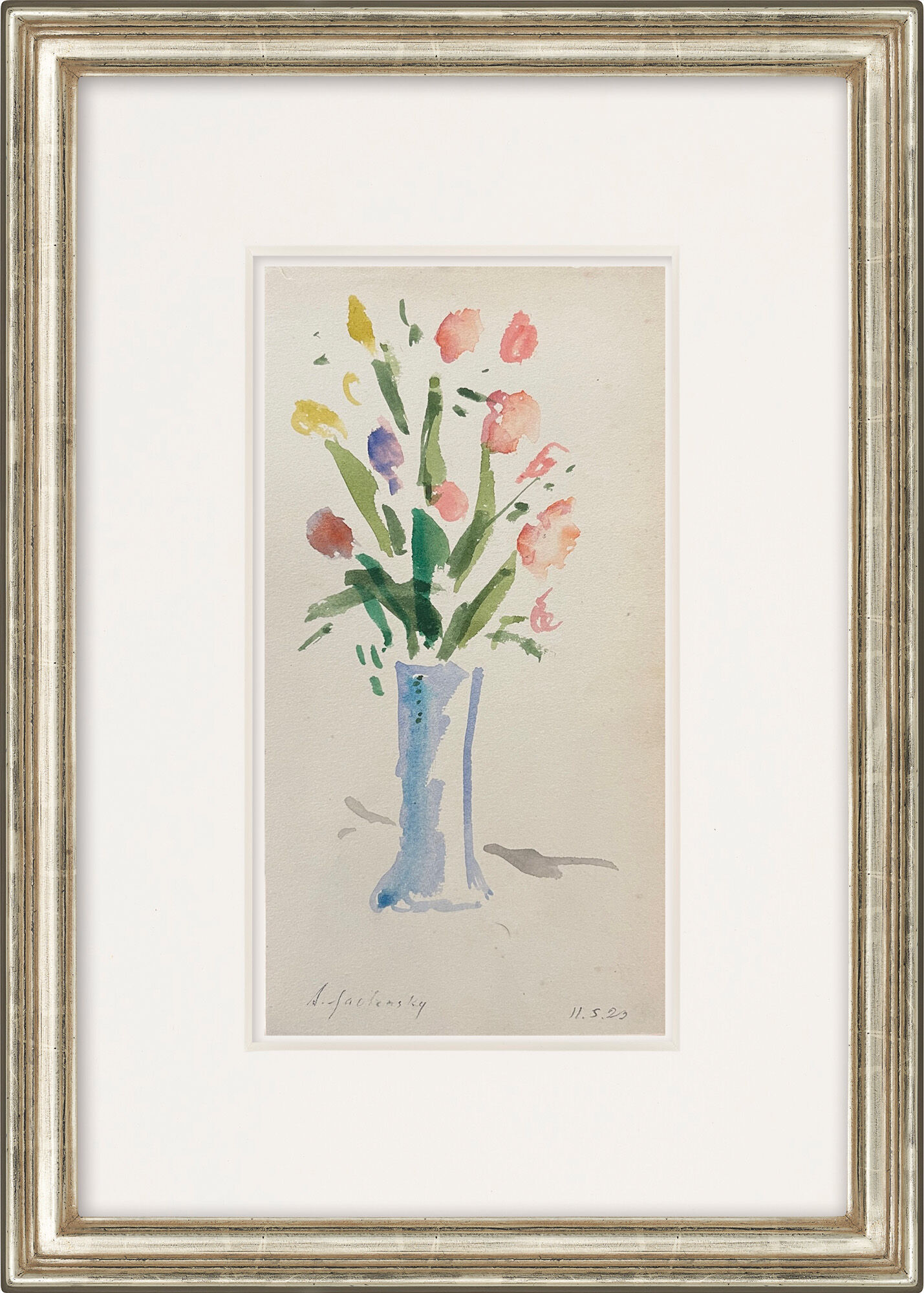Picture "Blue Vase with Pink, Yellow and a Dark Blue Flower" (1923) (Unique piece)


Picture "Blue Vase with Pink, Yellow and a Dark Blue Flower" (1923) (Unique piece)
Quick info
unique piece | signed | certified | watercolour and pencil | framed | size 41 x 31 cm
Detailed description
Picture "Blue Vase with Pink, Yellow and a Dark Blue Flower" (1923) (Unique piece)
Jawlensky developed his own colour theory with which he was able to stage the colours particularly effectively. For the pictorial objects, he postulated that the forms had to be freed of everything incidental in order to give strong expression only to what was necessary for this way.
This philosophy is also reflected in this watercolour painted in 1923. The flower still life is defined by the vase and the individual blossoms without missing anything, quite the opposite: in the concentration on the essentials, the magnificent colours, in particular, are superbly expressed.
Watercolour and pencil, 1923. Signed. With a certificate from the Alexej von Jawlensky Archive. Motif size/sheet size 18.6 x 9.6 cm. Size in frame 41 x 31 cm as shown.

About Alexej von Jawlensky
1864-1941, German-Russian painter
It was not until 1889 that the former Russian Imperial Guard Alexej von Jawlensky in the Tsarist army began his artistic training. In 1896, he moved to Munich to attend a private art school where he met Wassily Kandinsky. In Murnau Jawlensky first worked together with Kandinsky and Gabriele Münter. And together they founded the Artist's Association "Neue Künstlervereinigung München". In addition, Jawlensky was a key member of the "Blauer Reiter" movement. He later co-founded the group "The Blue Four" with Klee, Kandinsky and Feininger.
Expelled from Germany as a Russian citizen in 1914, during the beginning of World War l, the artist settled in Switzerland and later in Wiesbaden, Germany. During this time he created his famous abstract heads. Jawlensky died of a serious illness in 1941.
"My art is meditation or prayer in colours", Jawlensky once said, and indeed his work is characterised by great religiousness. This is particularly noticeable in the series of works of the Saviour’s faces and the abstract heads, which Jawlensky summarises in his memoirs as "saints' heads". The influence of orthodox iconography is unmistakable, and they were already understood as a modern version of the icon by contemporary artist colleagues. The human face in many variations – mostly in strong, even bright colours – had already been a focus of his work before. With the saints' heads, he became more restrained in colour and reduced the subject of the portrait to the face itself. They seem de-individualised without losing expressiveness. A progressive abstraction, lead to an iconic form, which in the sequence seem like a search for an unattainable divine archetype.
Influenced by Fauvism, Alexej von Jawlensky painted with bright colours, fierce brushwork and dark outlines. His works are among the most sought-after works of classical modernism and can be found in the world's great museums.
Paintings with glazing watercolours, that are characterised by their transparency, which let deeper layers and painting surfaces shine through.
Often the paper surface is omitted. This contributes significantly to the effect of the work. The aquarelle painting requires skilful use of colour, as it dries quickly and corrections are almost impossible.
A one-of-a-kind or unique piece is a work of art that has been personally created by the artist. It exists only once due to the type of production (oil painting, watercolours, drawing, etc.).
In addition to the classic unique pieces, there exist the so-called "serial unique pieces". They present a series of works with the same colour, motif and technique, manually prepared by the same artist. The serial unique pieces are rooted in "serial art", a type of modern art, that aims to create an aesthetic effect through series, repetitions and variations of the same objects or themes or a system of constant and variable elements or principles.
In the history of arts, the starting point of this trend was the work "Les Meules" (1890/1891) by Claude Monet, in which for the first time a series was created that went beyond a mere group of works. The other artists, who addressed to the serial art, include Claude Monet, Piet Mondrian and above all Gerhard Richter.


